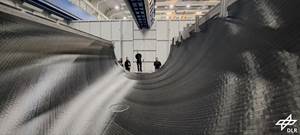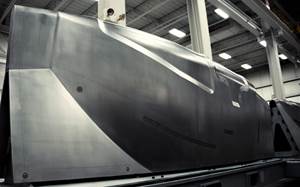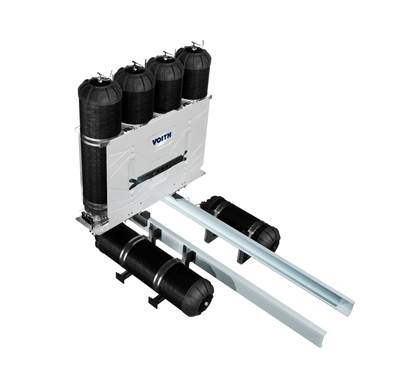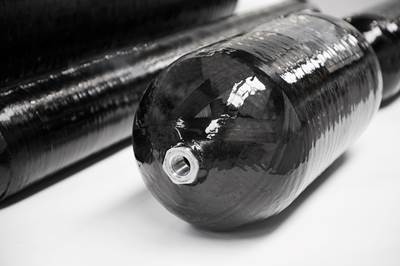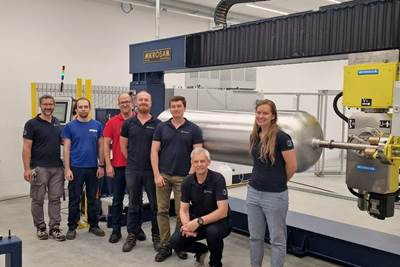Mikrosam, H2Storage collaborate on 300+-liter Type IV hydrogen tanks
Automated filament winding cell achieving wind speeds of 6 meters/second improves production performance, shortens curing cycle for serial production of 700-bar Type IV tanks.
Mikrosam (Prilep, Macedonia) and H2Storage (The Hague, Netherlands) are collaborating on a project to develop 700-bar Type IV cylinders for hydrogen storage. Using composite materials, Mikrosam’s fully automated filament winding cell for Type III and IV overwrapped compressed natural gas (CNG) and hydrogen (H2) tanks and both teams’ expertise, production productivity was successfully increased and part performance and consistency improved for H2Storage’s 300+-liter storage tanks. The target is to reach optimal product design for serial production.
“Your goal is to save energy: either due to changing regulations, cost reductions or simply because you care about the environment for future generations,” Michel Tamarzians, chief engineer at H2Storage, says. “We offer sustainable solutions to companies in the field of hydrogen. All the way from hydrogen storage up to (re)filling of your hydrogen stock and fleet. Hydrogen will get you further up the road!”
The 700-bar Type IV cylinders designed by H2Storage reach a length of 2,300 millimeters with an outer diameter of 520 millimeters, optimized to store approximately 1,400 kilograms of hydrogen in a 45-foot container at 700 working pressure. They consist of a polyamide (PA) liner which reduces the diffusion of hydrogen compared to high-density polyethylene (HDPE) liners currently used in the market. Furthermore, H2Storage uses towpreg carbon fiber and glass fiber supplied by TCR Composites (TCR, Salt Lake City, Utah, U.S.) instead of the traditional wet winding process. This results in higher winding speeds, shorter production times and no messy production facilities due to resin residues, the company says.
The tanks from H2 Storage are intended for the distribution of compressed hydrogen from point to point with various transport modes, including containers, etc., in order to facilitate and speed up the availability of hydrogen energy to end-users. Their length and diameter also enables them to fit behind heavy-duty trucks, buses and construction machinery such as an excavator. In particular, the Type IV cylinders developed in collaboration with Mikrosam are to be applied to a range of industries. This includes integration into multiple element gas containers (MEGCs) for the transport and storage of large quantities of hydrogen for road and sea transport according to ADR and ADN.
The product development at Mikrosam involved several iterations to determine the best winding method and composite design with material optimization to meet the necessary standards. Several tanks were developed with different composite designs, including thermocouples to understand and optimize the curing cycle.
The machine used for the project is capable of winding speeds up to 6 meters/second with very high fiber tension upwards of 100 newtons. According to Mikrosam, this capability and enhancements were required and successfully demonstrated earlier this year for an Asian Tier 1 customer for its next generation of CHG tanks.
“Whether it is wet or towpreg winding, when it comes to the production of tanks for hydrogen, it is essential that filament winding machines provide maximum flexibility for development, and the ability to scale the process to reach the highest capacity and still not break the bank,” Vele Samak, general manager at Mikrosam, says.
Through these various iterations, Mikrosam and H2Storage report improved performance in regards to the winding layers — the amount of towpreg was decreased, while still reaching the desired burst pressure — and the curing profile was shortened for serial production.
“H2Storage chose Mikrosam for its ability to deliver a fully automated serial production line,” Tamarzians explains. “Thus, starting development with Mikrosam for their availability of technicians, machines and the experience was an essential factor. The process helps us to improve the combination of tension and composite layers to optimize the material usage during winding. Additionally, the flexibility from Mikrosam is one of a kind, which is essential during prototyping and pre-series phases.”
With more than 30 years of experience, Mikrosam partners with customers on development projects for improving the filament winding process and the development of a new generation of high-capacity carbon fiber tanks for hydrogen. The company has its own R&D lab and engineering team, with a range of in-house laboratory testing and production machines, including automated fiber placement (AFP), filament winding for both wet and towpreg winding, and prepreg slitting; its equipment covers many applications in the hydrogen value chain for buffering, storage, transportation, distribution and end-use.
In addition to its collaborative project with H2Storage, Mikrosam is currently commissioning its latest and largest automated filament winding line for H2 tanks for a customer in China in the automotive industry, which is dedicated to the high-speed wet winding process. It achieves 2 meters/second maximum wet winding speeds, and about 1.5 meters/second combined angles winding speed overall.
Featuring a high level of automation, it is equipped with two four-spindle filament winding machines, an automatic resin mixing and delivery system, programmable doctor blades for resin pick-up control, and an automatic handling system dedicated to handling the liners between all stations in the cell, starting from liner assembly up to the final vessel.
The automatic work for the process flow is controlled by Mikrosam’s TCON automation system. This advanced feature is integrated with the company’s quality control system (QCS), providing continuous online monitoring and traceability to achieve high quality. Optimized efficiency, high-speed production, increased capacity and profitability, reduced material waste and minimum human intervention are a few benefits.
Over the past few years, H2Storage, a Dutch startup driven by highly experienced directors from the energy sector, has invested in an alternative solution to store more H2 under pressure, to be realized through Type IV composite cylinders with operating pressures up to 700 bar and filling pressures up to at least 875 bar. H2Storage says it develops lightweight high-pressure tanks that are not only safe but are also produced from recyclable material. Various storage products have been developed with this tank as a foundation including a mobile gas station; durable emergency generators, a composite tank solution for heavy transport; and an H2 storage container.
Currently, the company is involved in two integration projects, a zero-emission excavator and a zero-emission inland waterway vessels, both of which will incorporate 700-bar Type IV tanks for the storage and supply of H2 for fuel cells delivered by H2Storage. The excavator project, ECO-Excavator, will be operational by the end of this year. The second integration project, Sh2ipdrive, is still in the early stages of engineering and testing, with operations expected for end of 2024.
Related Content
DLR completes MFFD upper shell skin layup
Eight-meter-long CFRTP fuselage skin was achieved via laser-heated in-situ consolidation, with stringers, frames and cleats to be welded.
Read MoreNine factors to consider when designing composites cure tooling
Gary Bond discusses the common pitfalls and compromises when designing good cure tooling and their holistic significance for a robust composite production process.
Read MoreIntelligent autoclaves emphasize sustainability, efficiency
CAMX 2023: Olmar introduces its “intelligent” autoclave, a combination of the company’s Industry 4.0 technology and its 75 years experience in autoclave and oven manufacture.
Read MoreThermal processing workflow software effectively monitors composite processing equipment
CAMX 2023: State-of-the-art, user-friendly PCS 2.0 showcased by Walton Process Technologies is an Industry 4.0 process control software for autoclaves, presses and ovens.
Read MoreRead Next
Voith H2 storage tanks made with in-house towpreg winding
Plug & Drive H2 storage system displayed at IAA Transportation 2022 uses 700-bar tanks for heavy-duty commercial and construction vehicles.
Read MorePlastic Omnium announces construction of Compiègne hydrogen storage vessel facility
Government-funded future factory will produce 80,000 Type IV storage vessels/year, adds to large contacts for design, production of 700-bar hydrogen vessels.
Read MoreCryomotive to manufacture first CRYOGAS hydrogen storage vessels using Mikrosam winder
Carbon fiber-reinforced composite cryogenic compressed (CcH2) system offers up to 80 kilograms of H2 and 1,000 kilometers of range for heavy-duty truck and bus applications.
Read More

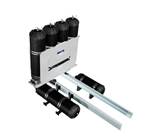
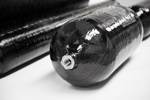
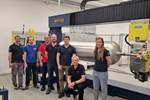
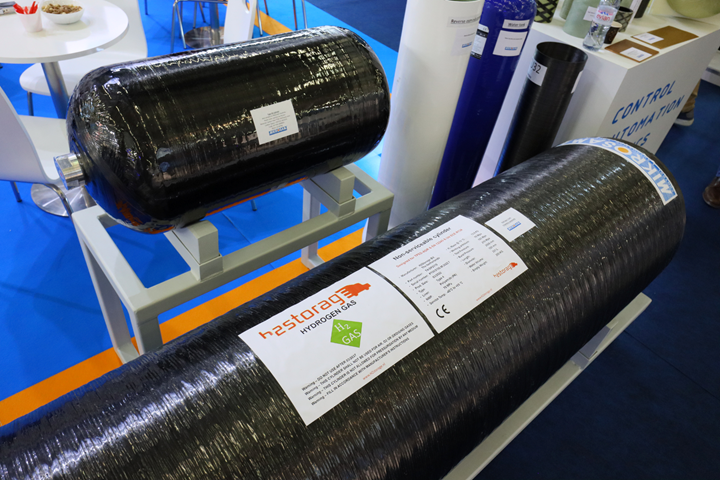



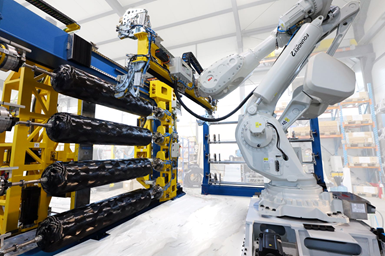
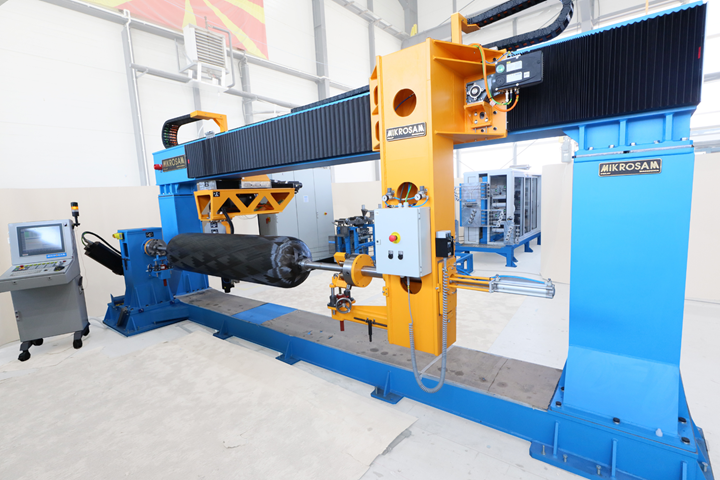



.jpg;maxWidth=300;quality=90)







